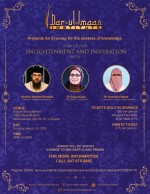SYED JAWED ANWAR
First Published: Muslims Weekly, New York June 18, 2004, Issue No.#224
MUSLIMS had intellectual, moral, geographical, scientific, and industrial superiority and vast human and natural resources over the West before Muslim lands were occupied by Western powers. The West had no edge over the Muslim world other than that attributed to political and military conspiracy, lies, deception, and propaganda --all fueled by disinformation and misinformation. With no concept of selfish nationalism, Muslims allowed Western companies, businessmen, and professionals in Muslim controlled lands. Muslims believe that this earth and all its resources belong to the Creator Allah and that everybody has the right to settle anywhere in the world. There was no requirement of passport, visa, or permission to enter into and reside in any Muslim country. The first Islamic state in Madinah, under the rule of Prophet Muhammad (saw), had only one condition of citizenship, which was “ having a desire to live in Madinah.” A person of any faith, race, and ethnicity could live in Madinah and enjoy full religious freedom in his or her personal and family life if he or she wanted to live there. Throughout history, before the eighteenth and nineteenth centuries’ colonization and before “secularization” and “modernization,” all post-occupation, Muslim governments and rulers retained this principle of citizenship.
At one time, India, particularly its Capital City Delhi, was where people of arts, literature, all kinds of skills, and technology from all over the world were always eager to come, live, perform, and excel. According to an Urdu poet, “Dilli jo tha Aalam me Intikhab” (Delhi was a city of distinction in the world). India was an industrially advanced nation throughout history. Various products of India were in great demand all over the world, and there was a huge flow of wealth towards India until the eighteenth century and the British occupation. Known as “the gold bird,” India experienced its best and golden period of business and industry under the Muslim rule of Allauddin Khiljee (695H/1296A-1716H/1316A) and Mughal Empire Shahjehan (b.1037H/1628A-d.1068H/1657A). During these two reigns, there was general prosperity, and India had an exemplary position, which prevailed until the British occupation. According to several British historians, the seths (businessmen) of Bengal had a business all over the world equivalent to the Bank of England (the largest bank of England). According to Captain Alexander Hamilton, “The assets of Mr. Abdul Ghafoor, a businessman of Surat (in Gujarat, India), are more than the total assets of East India Company” [Musalmanon kaa Roshan Mustaqbal (in Urdu) by Mohammad Tufail Ahmed Manglori].
Syed Ahmed Shaheed, a great Mujahid and freedom fighter, stayed, along with his team, in Calcutta in 1821 during their journey for Hajj. They were guests of a big businessman Ghulam Hussain who took bait (oath) at the hand of Syed Shaheed. The author of Wiqa e Ahmadi has written that Mr. Hussain’s business expanded into different countries and far places in the world, and he had houses in different countries. From the head office of Calcutta, the team of Mr. Hussain conducted business correspondence in thirteen languages --English, French, Chinese, Turkish, Arabic, Farsi, Kokni, and Indian provincial languages.
Muslims did not have an organized academic curriculum for the education of business and technology in Madrasahs, but this education was available in the factories and business centers. Students were welcomed and encouraged to gain knowledge in working and practical environments. The industrial position (some of the sectors) of Muslim India was as follows:
Textile Industry
The "birthplace" of cotton is India. According to Siyuti, “The word Sundas in the Qur’an indicates the cotton of Sindh (presently a province of Pakistan). Indians wore sophisticated cotton clothes at the time when most other people were wearing coarse clothes of wool. The military personnel of Alexander of Greece first saw cotton fields in Sindh and considered “the trees of cotton” as one of the “wonders of the world.” The English word cotton and the Arabic word Qatan derived from the Hindi word Kaatna.
Julahas (weaving workers) of India had a monopoly on the world’s cotton clothing industry. Muslim rulers promoted and facilitated this industry at its highest level. Shams Siraj Afeef has written about the period of Feroz Tughlaq (752H/1351A-790H/1388A), “There were twelve thousand industrial workers in thirty-six royal factories located at different places. The chief of the factory was called ‘Malik’ or ‘Khan.’ The chief executive of all the factories was Khawja Abul Hasan. Different clothes were produced here by order of the government.”
Sultan Muhammad Khilji, the ruler of Malwa, took great interest in women’s education in skill areas. According to famous historian Farishta, he provided women with training in carpet weaving, knitting, and cloth/dress making.
India produced dozens of types of sophisticated clothes --Garha, Gazi, Nainsukh, Malmal, Mashroo, Mahmoodi, Kashmiri, etc. The centers of manufacturing of Kamkhab and Zartar were Surat and Varanasi (Banaras). The centers of manufacturing of Malmal were Bengal and Azeemabad (Patna). Aab e rawan, Shabnam, and Hawabeft were different names of malmal. A sophisticated bolt of malmal (the finest cotton) ten yards long and one yard wide weighed only four ounces and could be passed through a finger ring.
Indian clothes were in huge demand all over the world. The English name of zartar was brocade and named after a city of India, Bharuch, a seaport in Gujarat and export center of the cloth. Calico was a cloth called cheent in the local language and named after Calicut, a harbor and export center in Kerala. When India’s clothing dominated the market of England, the local industrialists began protesting, and they demanded a ban on the import of Indian clothes. In the name of protecting local industries, the British government passed the Calico Acts between 1700 and 1720, thereby legislated it a crime to sell or wear Indian clothes in England.
When the British got control over Bengal and various industrial centers of India, they enforced several rules and regulations to destroy the industry completely. Jullahas practically became a bonded labor of the British Government, and labor oppression on these workers was so immense that most of the workers cut their thumbs to have an excuse of disability (The Rule of Company by Bari).
Arms Industry
India was in arms manufacturing country from ancient times. In Arab lands, the Indian sword Saiful Hind was popular long before Islam. Different type of arms were manufactured in ancient times --swords, knives, daggers, and various sharp blades known as bhala, bercha, katar, garz, etc. Muslims are credited with several innovations in the arms technology of the time, including new types of arms --tampancha, bandooq (guns), Gajnaal, Rehgala, Zanboorak, and tanks. Hakim Abul Fateh Gilani invented a twelve-fire gun for Emperor Akbar (1014H/1605A). The tanks, Lamdhek and Malikmaidan of Beejapur and Zamzama of Lahore, manufactured in Muslim India, are still recognized as examples of fine skill and technological expertise.
In the war against Britain in 1763, Nawab Mir Qasim Khan used the native gun Maskeat. Broome, in his book History of Bengal Military, admitted that Nawab’s Masketa was superior to the Tower Proof (the gun used by Britain’s East India Company military) and that its barrel was excellent.
The tank Chaqmaq was also collected from the mountains of Rajmahal. After 1806, England started manufacturing tanks on the Indian pattern. Indian tanks were light, effective, mobile, and easily transported. Duke of Willingdon, an opponent of Tipu Sultan, praised the tanks of Tipu Sultan. In 1815, during the Duke’s fighting with Napoleon, Duke stated that he wished he had a tank like Nagori Bail of Tipu Sultan so that he could easily conquer.
The British occupiers couldn’t tolerate this sensitive and important Indian arms industry. By the charter of 1813, the British government forced the closing of India’s furnaces for iron and steel casting. As a result, a nation, once superior in arms manufacturing became dependent on England and Japan for things even as simple as needles and pins.
Ship Industry
The best and strongest wood of the world, sagwan, was exclusively available in India, the center of ship industry. The ships built by sagawan were seaworthy for fifty years while the European ships had a lifespan of twelve years. Indian-built ships were in demand all over the world. The ports of Murshidabad, Bengal and Surat, Gujarat were famous for this industry. Abdur Raheem Khan Khanan (1036H/1627A), during his governorship of Gujarat, built three big ships --Raheemi, Kareemi, and Salari. In the season of Hajj, these ships provided free transportation to poor Muslims to Jeddah. These ships were continued manufacturing until the British destroyed the industry completely in 1868.
Although Muslim India was never a naval power, fleets were available to defend the ports. Emperor Akbar established fleets that were available in the Bay of Bengal and ports of Gujarat. When the British Company occupied the Bengal, they captured and controlled the navy of 768 armed and fast-running boats.
Chemical Industry
The two living examples mentioned by Professor Muhammad Saleem in his book, Musalmanon ka Nizaam e Taalim and Tarbiyah, proves Muslim India’s superiority in the chemical industry. One is the calligraphy using an indelible ink on the inner doors of Jama Masjid Delhi. After three hundred years of abusive winter and summer weather, the calligraphy is still bright and vivid. This proves the high quality of the chemicals. The other example amazed British occupiers who saw the Taj Mahal, built in Agra by order of Emperor Shahjehan (1323H/1905A). The water of the pond was always warm without any visible source of heat. When Lord Curzon became viceroy of India in 1905, he eagerly wanted to know the “secret” of the source that maintained the water’s temperature. The bottom of the pond was broken to uncover the amazing cup of burning chemicals. It was deactivated by exposure to the air.
Most Muslim countries and their lands were physically liberated by the middle of the twentieth century, but they are still psychologically occupied through the Western education system, economy, culture, media, and the corrupt political agents, dictators, and military powers. They are practically enslaved and not free to decide their own destiny. The Western criticism on Islamic systems, governments, and intellectual contributions in the modern world is the criticism from those who enslaved and cut the hands and feet of a far superior nation of the history.
(This is a series of columns for the understanding of the history of centuries old Madrasah and Islamic Education System in South Asian perspective published in the Muslims Weekly, New York, USA, in series of the weekly column “Personal Notes.” Syed Jawed Anwar can be reached at Jawed@seerahwest.com)






